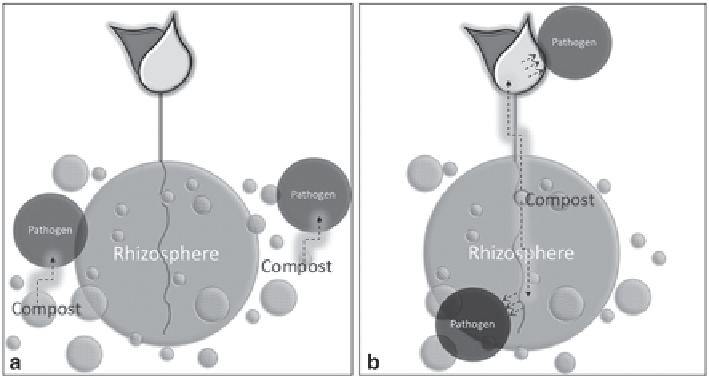Agriculture Reference
In-Depth Information
Fig. 8.1
Schematic representation of the two possible mode of action through which the compost
can suppress disease development: toward the pathogen (
a
) or toward the plant stimulating its
systemic reaction (
b
)
growth, activity and fecundity: this phenomenon is called microbiostasis (Hoitink
and Fahy
1986
; Lockwood
1990
). The nutrient competition for a pathogen often
means contend space and infection sites too.
8.3.1.2
Antibiosis
Antibiotic-mediate suppression involves those microbes that produce and secrete
one or more compounds with detrimental activity for various plant pathogens; a
process known as antibiosis (Hoitink et al.
1996
). This antagonistic path in addition
to the antibiotics can also include lytic enzymes, and other products of microbial
metabolism. Bacteria belonging to the thermophylic
Bacillus
group, for example,
have received greater attention because they produce antimicrobial compounds
associated with bio-control with a broad-spectrum activity. These include antibi-
otics, such as bacillomycin, iturin A, mycosubtilin and Zwittermycin A (Leifert
et al.
1995
), lipopeptides (Ahimoua et al.
2000
; Pal Bais et al.
2004
) and antifungal
proteins (Liu et al.
2007
). Moreover, are well known the 2,4-diacetylphloroglucinol,
phenazines, pyoluteorin and pyrrolnitrins produced by
Pseudomonas fluorescens
,
the pseudanes (quinolinones) from
Burkholderia cepacea
or the gliotoxin secreted
by fungi belonging to
Trichoderma
groups. An important role in this suppressive
path was also played by lytic enzymes, such as various chitinases, glucanases and
proteases. Singh et al. (
2010
) has reported
Pseudomonas aeruginosa
PN1 produces
citinase and β-1,3-glucanase caused 69 % colony growth inhibition of fungal phy-
topathogen
Macrophomina phaseolina
and exhibited a strong bio-control agent. In
this series presence of protease, chitinase, lipase and β-1,3 glucanase (lysogenic
enzymes) in the compost, indicates a possible role in fungal degradation (El-Masry
et al.
2002
).

